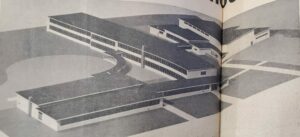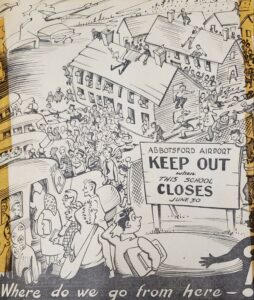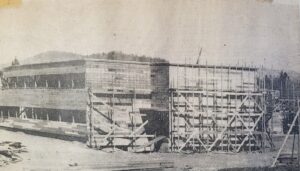With a rising population in MSA schools, many of the individuals being students, more classroom space and resources were demanded. This class space was delivered in multiple forms such as re-opening, adding onto or retrofitting existing schools, building new schools, and re-purposing other buildings nearby.
In 1948, overall attendance in MSA schools reached 3,000 pupils. Additionally, it was becoming more and more common for students to complete high school, whereas before it was rare for students to make it past grade 10. To accommodate the increase of students, community halls were often being re-purposed for classroom use. These community halls were Aberdeen, Clearbrook, Bradner, Masonic and Orange. As it was known that these could not be permanent solutions, a massive school project was proposed. This included a 30-room high school which could hold 1,000 students. Included in this plan were a “large” (1941-1950 Newspaper) gymnasium, home economic room, wood and metal shop rooms, a drafting room, library, and an auditorium. The high school was also planned to accommodate future additions, should the need for more classroom space arise.
All in a Vote
In 1949, 40% of MSA students were instructed in 36 makeshift classrooms, amounting to approximately 1,000 students. The MSA called for a vote to be held on October 1st the same year, which would determine whether to proceed with $1,540,808 worth of school construction projects. These projects were to include the following:
New Schools:

Proposed Abbotsford Junior-Senior Secondary school from a promotional voting poster (The Reach, 1941-1951 Newspaper Clippings)
- Barrowtown Elementary – two rooms
- Ridgedale Elementary – one room
- Junior-Senior Secondary School- 30 rooms (previously mentioned)
Additions to existing schools:
- Bradner School – three rooms
- Aberdeen School – two rooms
- North Poplar School – five rooms
- South Poplar School – two rooms
- Upper Sumas School – one activity room
- Improved plumbing and heating for all MSA schools

(The Reach, 1941-1951 Newspaper Clippings)
In 1950, another vote was to be held on December 14th and 16th to show public support for resolving the problem of over crowded schools. Part of the petition was to take the classroom load off of the Abbotsford Airport. It was stated that the Canadian Air Force ordered the Airport classroom operations to cease by June 30th, 1951. It was further addressed that students will need educational accommodation by that time or else they, that is, all 21 classrooms, could be left “out on the roadside” (1941-1950 Newspaper).
By September of 1951, Phillip Sheffield High School reached 400 students in attendance. The school was in the process of converting four bus stalls into classroom space, as teachers were suffering overcrowding. In fact, classrooms on average at Phillip Sheffield totalled fifty students each. By 1952, Phillip Sheffield High had 21 classrooms within and outside of the school itself.

Construction of Abbotsford Senior Secondary School (The Reach, 1953-1956 Newspaper Clippings)
In 1952, there were plans to build a 16 room senior secondary school next to the junior secondary school. By 1955, construction had begun on the senior secondary school.
1955 was a monumental year for MSA schools and their students. It was the first year since WWII that every student attended a permanent classroom. In other words, no students were in temporary classrooms.
Sources for this page:
MSA Educational Area “News Clippings” October 1941 to December 1950, (1950) The Abbotsford Reach.
School District NO. 34 (Abbotsford). “Clippings from the Abbotsford, Sumas, and Matsqui News” January 1951 to March October 21, 1953”. (1953), The Abbotsford Reach.
School District NO. 34 (Abbotsford). “Clippings from the Abbotsford, Sumas, and Matsqui News” October 28, 1953 to March 7, 1956”. (1956), The Abbotsford Reach.
